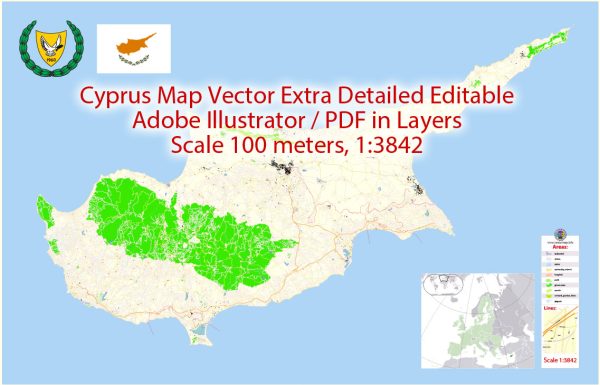Vector Maps of the Cyprus : island in the Eastern Basin of the Mediterranean Sea. It is the third largest island in the Mediterranean, after the Italian islands of Sicily and Sardinia, and the 80th largest island in the world by area. It is located south of the Anatolia peninsula, yet it belongs to the Cyprus arc. Cyprus may be included in Europe or West Asia as the island is close to Southeast Europe and the Middle East. Cyprus also had lengthy periods of mainly Greek and intermittent Anatolian, Levantine, Byzantine, Turkish and Western European influence.
Area:
• Total: 9,251 km2 (3,572 sq mi)
• Water: (%) 9
Download royalty free, editable vector maps of Cyprus in high resolution digital PDF and Adobe Illustrator format.
The political and economic history of Cyprus is complex and has been shaped by various civilizations, conflicts, and geopolitical influences over the centuries.
Vectormap.Net provide you with the most accurate and up-to-date vector maps in Adobe Illustrator, PDF and other formats, designed for editing and printing. Please read the vector map descriptions carefully.
Here is a detailed overview:
Ancient and Classical Periods:
- Cyprus has a rich ancient history, with evidence of human activity dating back to the Neolithic era.
- In antiquity, Cyprus was inhabited by various civilizations, including the Mycenaeans, Phoenicians, and Assyrians.
- The island became part of the Achaemenid Empire in the 6th century BCE and later came under the rule of Alexander the Great.
Hellenistic and Roman Periods:
- Cyprus was a part of the Hellenistic Seleucid Empire after Alexander’s death, and later it came under Ptolemaic rule.
- The island became a Roman province in 58 BCE after the Roman Republic annexed it.
- During Roman rule, Cyprus prospered economically, and its cities flourished.
Byzantine Period:
- The Byzantine Empire ruled Cyprus from the 4th to the 12th century.
- The island faced Arab invasions in the 7th and 8th centuries, leading to significant changes in its demographics.
Medieval Period and Crusades:
- In 1191, Richard the Lionheart of England conquered Cyprus during the Third Crusade.
- Richard later sold the island to the Knights Templar, who, in turn, sold it to Guy de Lusignan.
- The Lusignan dynasty ruled Cyprus until 1489 when it passed to the Venetians.
Ottoman Period:
- The Ottoman Empire conquered Cyprus in 1571 after defeating the Venetians.
- Ottoman rule continued for nearly three centuries, during which the Greek Orthodox majority and Turkish Muslim minority coexisted.
British Colonial Period:
- The British Empire took control of Cyprus in 1878, initially as a result of the Congress of Berlin, and later it formally annexed the island in 1914.
- During British rule, tensions between the Greek and Turkish communities increased, leading to nationalist movements seeking Enosis (union with Greece) or Taksim (partition).
Independence and Intercommunal Strife:
- Cyprus gained independence from Britain in 1960.
- Intercommunal tensions between the Greek Cypriot majority and Turkish Cypriot minority persisted, culminating in violence in the 1960s.
Turkish Invasion and Division:
- In 1974, a military coup by Greek nationalists seeking Enosis prompted a Turkish military intervention.
- The result was the de facto division of Cyprus, with the northern part under Turkish control and the southern part remaining predominantly Greek Cypriot.
Contemporary Period:
- The Republic of Cyprus, consisting of the southern part of the island, is internationally recognized as the legitimate government.
- The northern part remains under Turkish control and is recognized only by Turkey.
- The issue of Cyprus remains a source of tension between Greece and Turkey, affecting Cyprus’ political and economic landscape.
- Efforts for reunification and peace talks have occurred, but a comprehensive resolution has proven elusive.
Economic Development:
- The Republic of Cyprus has developed a diversified economy, with services, tourism, and shipping being key sectors.
- Cyprus faced economic challenges, particularly with the 2012-2013 financial crisis, leading to a bailout from the International Monetary Fund and the European Union.
In summary, the history of Cyprus is marked by a complex interplay of ancient civilizations, foreign dominations, and internal conflicts, shaping its political and economic trajectory up to the present day. The division of the island remains a significant geopolitical issue with implications for regional stability.


 Author: Kirill Shrayber, Ph.D.
Author: Kirill Shrayber, Ph.D.